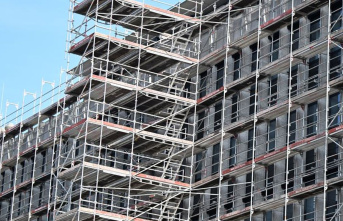The US Federal Reserve (Fed) is leaving the key interest rate unchanged at a high level for the sixth time in a row in view of stubbornly high inflation. On Wednesday, she did not promise an interest rate cut any time soon. The key interest rate now remains in the range of 5.25 to 5.5 percent - the highest level in more than 20 years. Commercial banks can borrow central bank money at this rate. “Inflation is still too high,” said Fed Chairman Jerome Powell. It could take “longer than previously thought” for the Fed to gain more confidence that high inflation is really on the decline.
The central bank of the world's largest economy has raised its key interest rate by more than five percentage points at a record pace since March 2022 in the fight against inflation. Recently, however, she no longer turned the interest rate screw. However, price increases in the USA have recently unexpectedly accelerated again. That's why some analysts have not ruled out the possibility that the Fed could even raise interest rates again. "I think it's unlikely that the next interest rate move will be a hike," emphasized Powell.
High inflation in the USA is proving to be persistent. The inflation rate in March rose more than expected. According to the Labor Department, consumer prices rose by 3.5 percent compared to the same month last year. Analysts had expected an average rate of 3.4 percent. In February it was still at 3.2 percent. The Fed is aiming for an inflation rate of 2 percent. In recent months there has been no further progress towards this target, the Fed has now announced. Powell said he was confident that the inflation rate would fall this year. However, this confidence has waned somewhat due to the data.
The inflation rate has fallen significantly since the interest rate increases, and prices are now rising much more slowly. At more than 9 percent in the summer of 2022, the rate was higher than it had been in around four decades. Nevertheless, the 2 percent target currently seems out of reach.
Good economic data
For the Fed, the fight against high consumer prices is a balancing act. It is turning the interest rate screw to slow down demand. If interest rates rise, private individuals and businesses have to spend more on loans - or they borrow less money. Growth is slowing, companies cannot pass on higher prices indefinitely - and ideally the inflation rate is falling. If interest rates are too high, there is a risk of a recession. However, the US economy is surprisingly strong despite high interest rates. The good economic data is not exactly putting pressure on the Fed to raise interest rates quickly. At the same time, the Fed announced on Wednesday that it would reduce its bond holdings more slowly.
The US Federal Reserve had actually forecast three interest rate cuts of 0.25 percentage points each for this year. In an estimate published in March, the Fed assumed a key interest rate of 4.6 percent on average for 2024. After the current meeting, the central bankers did not publish a new forecast on Wednesday. This will only come after the next Fed meeting in June. Given the stubbornly high inflation, it is now unclear whether there will actually be three interest rate cuts this year. Analysts assume that a rate cut is not expected until September at the earliest. Some of them also suspect that there could be just one rate cut this year.
When asked whether three interest rate cuts this year were realistic, Fed Chairman Powell responded evasively and said: "I don't think about it that way." If the Fed has enough confidence in the data, it will cut interest rates. But it is unclear how long this will take.
US President Joe Biden is also likely to be closely following the Fed's actions in the election year. Polls show that voters are dissatisfied with his economic policy. The main reason for this is high consumer prices. But the persistently high interest rates are also a problem for the Democrat. This is because it makes mortgages, credit card debts and student loans more expensive for people in the country. In the presidential election in November, the Democrat will most likely face off against the Republican ex-President Donald Trump.








